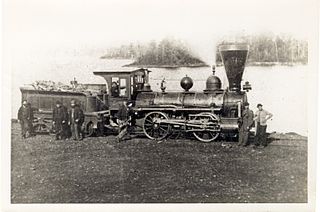
Lindsay is a community of 22 367 people on the Scugog River in the Kawartha Lakes region of south-eastern Ontario, Canada. It is approximately 43 km (27 mi) west of Peterborough. It is the seat of the City of Kawartha Lakes, and the hub for business and commerce in the region.

The Trent–Severn Waterway is a 386-kilometre-long (240 mi) canal route connecting Lake Ontario at Trenton to Georgian Bay, Lake Huron, at Port Severn. Its major natural waterways include the Trent River, Otonabee River, Kawartha Lakes, Lake Simcoe, Lake Couchiching and Severn River. Its scenic, meandering route has been called "one of the finest interconnected systems of navigation in the world".

Cobourg is a town in the Canadian province of Ontario, located in Southern Ontario 95 km (59 mi) east of Toronto and 62 km (39 mi) east of Oshawa. It is the largest town in and seat of Northumberland County. Its nearest neighbour is Port Hope, 7 km (4 mi) to the west. It is located along Highway 401 and the former Highway 2. To the south, Cobourg borders Lake Ontario. To the north, east and west, it is surrounded by Hamilton Township.

The Grand Trunk Railway was a railway system that operated in the Canadian provinces of Quebec and Ontario and in the American states of Connecticut, Maine, Michigan, Massachusetts, New Hampshire, and Vermont. The railway was operated from headquarters in Montreal, Quebec, with corporate headquarters in London, United Kingdom. It cost an estimated $160 million to build. The Grand Trunk, its subsidiaries, and the Canadian Government Railways were precursors of today's Canadian National Railway.

Port Hope railway station in Port Hope, Ontario, Canada, is one of the oldest Canadian passenger rail stations still in active use. Served by Via Rail trains running from Toronto to Kingston and Ottawa, it was also a stop for trains to and from Montreal until January 24, 2012. The station is unstaffed, but has a heated waiting room, pay telephone, washrooms, free outdoor parking, and wheelchair access.

Kitchener station is a railway station located in Kitchener, Ontario, Canada, slightly to the northeast of downtown Kitchener, at 126 Weber Street West, near the corner of Victoria Street. It is a heritage building containing a waiting room and ticket counter built beside a set of tracks also used as a freight yard. A separate building to the east of the passenger area, originally built in 1925 as a freight building, now serves as the headquarters for the Goderich–Exeter Railway.
The Midland Railway of Canada was a historical Canadian railway which ran from Port Hope, Ontario to Midland on Georgian Bay. The line was originally intended to run to Peterborough, but the competing Cobourg and Peterborough Railway was completed in 1854 and the owner's plans changed. Redirecting the line northward, it opened as the Port Hope, Lindsay & Beaverton Railway, a much longer line than originally planned. A further expansion launched in 1869 pushed the line westward towards Georgian Bay, and prompted renaming as the Midland Railway.
The Canada Atlantic Railway Company (CAR) was a historic North American railway located in Ontario, southwestern Quebec and northern Vermont. It connected Georgian Bay on Lake Huron with the northern end of Lake Champlain via Ottawa. It was formed in 1897 through a merger of three separate railway companies that John Rudolphus Booth had either purchased or created, beginning in 1879. The CAR was owned by Booth for eight years after its formation until he sold it to the Grand Trunk Railway (GTR) in 1904.
The Victoria Railway was a 55.52-mile (89.35 km) long Canadian railway that operated in Central Ontario. Construction under Chief Engineer James Ross began in 1874 from Lindsay, Ontario, with authority to build through Victoria County to Haliburton, Ontario, to which it opened on November 24, 1878. The line is best known as having been built by a large group of Icelandic immigrants, who found the Kinmount winters too rough, and so they all moved to Gimli, Manitoba. The line became part of the Midland Railway of Canada and then later part of the Canadian National Railways. The line was abandoned completely by the early 1990s.

The Toronto and Nipissing Railway (T&N) was the first public narrow-gauge railway in North America. It chartered in 1868 to build from Toronto to Lake Nipissing in Ontario, Canada, via York, Ontario, and Victoria counties. At Nipissing it would meet the transcontinental lines of the Canadian Pacific, providing a valuable link to Toronto. It opened in 1871, with service between Scarborough and Uxbridge. By December 1872 it was extended to Coboconk, but financial difficulties led to plans of the line being built further abandoned at this point. The railway merged with the Midland Railway of Canada in 1882.

The Cobourg and Peterborough Railway (C&PRy) was one of the first railway lines to be built in Central Ontario, Canada. The line was initially considered in 1831 as a way to bring the products from the burgeoning area around Peterborough to markets on Lake Ontario through the port in the town of Cobourg. Before the railway the only means of travel was by stage coach lines between larger populated areas overland or by boat. A series of problems, including the Upper Canada Rebellion and the Panic of 1837, meant that construction did not begin until 1853, reaching Peterborough in 1854.

The Port Whitby and Port Perry Railway (PW&PP) was a railway running from Whitby to Port Perry, running north–south about 50 km east of Toronto. It was built to connect local grain and logging interests with the railway mainlines on the shores of Lake Ontario. It was later extended northeast to Lindsay, becoming the Whitby, Port Perry and Lindsay Railway (WPP&L).

Canadian National Railway's Kingston Subdivision, or Kingston Sub for short, is a major railway line connecting Toronto with Montreal that carries the majority of CN traffic between these points. The line was originally the main trunk for the Grand Trunk Railway between these cities, although there has been some realignment of the route between these cities. The majority of the Kingston Sub runs close to the northern bank of Lake Ontario and the Saint Lawrence River.

The Central Ontario Railway (COR) was a former railway that ran north from Trenton, Ontario to service a number of towns, mines, and sawmills. Originally formed as the Prince Edward County Railway in 1879, it ran between Picton and Trenton, where it connected with the Grand Trunk Railway that ran between Montreal and Toronto. After being purchased by a group of investors and receiving a new charter to build northward, the company was renamed the Central Ontario Railway in 1882, and it started building towards the gold fields at Eldorado and newly discovered iron fields in Coe Hill.
The Lindsay, Bobcaygeon & Pontypool Railway (LB&P) was a short-line railway in Ontario, Canada. It was originally designed to serve sawmills in Bobcaygeon, running southward to the Ontario and Quebec Railway at Burketon, near Pontypool. Passenger service for weekender trips to the beaches on Sturgeon Lake was a major service later in the line's life.
The Georgian Bay and Seaboard Railway (GB&S) was a former short-line railway in Ontario, Canada, owned and operated by Canadian Pacific Railway (CPR). The first sections opened in 1908, and the entire 140 kilometres (87 mi) route was fully completed in 1912.
The Belleville and North Hastings Railway (B&NHR) was a short-line railway in Hastings County, Ontario, Canada. It branched off the Grand Junction Railway (GJR) north of Belleville and ended on the Central Ontario Railway (COR) outside Eldorado for a total distance of 33 kilometres (21 mi). In spite of its name, the line did not reach either Belleville or the northern part of Hastings County.
The Irondale, Bancroft and Ottawa Railway (IB&O) was a short line railway in Central Ontario, Canada. The line was originally opened in 1878 as the Myles Branch Tramway, a horse-drawn wagonway connecting the Snowdon Iron Mine to the Victoria Railway a few miles away. The line was taken over by a group looking to build a northern extension of the Toronto and Nipissing Railway (T&N) as the Toronto and Nipissing Eastern Extension Railway. This extension was never built; instead, the company rechartered as the IB&O and used the Tramway as the basis for a new line with the ultimate aim to connect Orillia to the Ottawa area.
The Wellington, Grey and Bruce Railway (WG&BR) was a railway in Ontario, Canada. It ran roughly northwest from Guelph to the port town of Southampton on Lake Huron, a distance of 101 miles (163 km). It also had a 66-mile (106 km) branch line splitting off at Palmerston and running roughly westward to Kincardine, another port town. A branch running south from Southampton was built during the construction of the Bruce Nuclear Generating Station in the 1970s.











